Few machines have such a deep, symbiotic relationship with others, yet the watch shares this type of relationship with not only cars, but aircraft and ships, too. With the first wearable timepieces having appeared in the 16th Century as large ‘clock-watches’, affixed to clothing and several inches across, coupled with the first Benz patented motor car not arriving until 1885-1886, here the aim is to explore just how there came to be such an affinity between what we see in today’s watches and cars, and perhaps better understand some of the modern day partnerships.
Firstly, it seems important to establish that the beginning of the Twentieth Century marked a critically important time in both the history of the wristwatch and the automobile.
Throughout the 16th and 17th Centuries, pocket watches were the timepiece of the era. It wasn’t until the mid-1800s that the first wristwatches appeared, and even then, these were only really worn by women as decorative pieces as opposed to the functional pocket watches preferred by gentlemen.
During the late 1800s, the pocket watch was found to be a cumbersome tool for soldiers to use effectively in wartime; by using wristwatches they were able to synchronise their operations collectively and discretely, giving them a distinct advantage over their enemy. Whilst the military theatre was indeed one market for wristwatches, there were others which materialised during this period, thanks largely to the industrial revolution, seeing an increase in the use of railroads, global travel, and the standardisation of time-zones across Europe and the USA.
With each of these came new and specific requirements of timepieces, leading to the concept of a “tool watch”, a phrase coined to describe a watch which serves a specific task (for example, diving watches). This concept is key to the very foundation of the relationship between watches and cars we know and celebrate today.
It is interesting to observe that around this period, we can see the founding of many celebrated watch manufacturers, including amongst others Breitling (1884), the origins of what is today TAG Heuer (1860), Rolex (1905), IWC Schaffhausen (1868), Audemars Piguet (1875), and Panerai (1860). Several decades later, the increasing popularity of the automobile would start to introduce a whole new realm of tool watch requirements.
Let’s park the wristwatch for a moment and look now at the automobile. As mentioned earlier, the very first automobile was patented as a vehicle ‘powered by a gas engine’ in 1885-1886 by Karl Benz, but the uptake of the automobile was rapid in comparison – within 20 years, the Ford Motor Company’s Model T had become widely available across the USA. However, the first convergence between time instruments and automobiles came even earlier in 1903, with British luxury good manufacturer Alfred Dunhill and their patented dashboard clock for automobiles; this was in turn followed in 1911 by the first patented dashboard chronograph from Heuer, known as the ‘Trip of Time’.
As the automotive industry grew and evolved, so too did organised motor racing. The concept of organised motor racing at this time was not new. Indeed, there are many recorded instances of races having taken place throughout Europe and the USA at the end of the 19th Century (for reference, the winner of a 732-mile course is recorded as having taken 48 hours and 47 minutes; another winner of a 54-mile course is recorded as having taken 7 hours and 53 minutes. These average speeds equate to less than 15mph and 7 mph respectively!)
The first purpose-built racetracks opened for racing in the early 1900s, instantiating tracks such as Brooklands in the UK in 1907, and the Indianapolis Motor Speedway in the USA in 1909; each circuit designed to challenge both driver and machine alike.
From these initial bases, it is then a natural human desire to progress. This desire is inherently driven by the compulsion to be better. To improve. To do something faster or more efficiently, with greater accuracy and precision.
It is particularly easy to see how one might apply this within motor racing and it is therefore unsurprising to learn that, not long after these purpose-built racetracks begun to appear, the European Grand Prix championships started during the 1920s and 1930s, challenging drivers and machines and pitting them against each other. These championships transpired to be the first incarnation of what we now know today as Formula 1 – the inaugural World Championship of Drivers took place in 1950 after the first FIA standardised ruleset.
Watches and cars – a match made in heaven
During the first half of the Twentieth Century, both the fields of horology and automobiles progressed extensively, with war-time innovation of machines used across land, sea and air proving vital and valuable. The operators of these continually improving machines were increasingly supported through better, more accurate timepieces with functional purposes, such as precision chronometers, timepieces with a chronograph complication, and purpose-built diving watches.
Following the Second World War, we enter a truly golden era for motor racing, watches, and the relationship between these through the 1950s and 1960s.
Motor racing legends including Stirling Moss, Jim Clark, Sir Jackie Stewart, Jack Brabham and Bruce McLaren graced the paddocks of a completely different Formula 1 than we see today. Back then, the risks were huge, and the sport was as exciting and glamourous as it was dangerous, with fatalities sadly not uncommon. However, Formula 1 was not the only popular racing format, with other infamous races such as Le Mans (from 1923), IndyCar (from 1911), and NASCAR (from 1949) very much in the public eye.
Of course, the common goal within motor racing is to complete the race in the fastest time possible. As the cars improved, so did the need to be able to measure their race times more accurately. Enter the chronograph…
Chronographs are a timepiece complication which enable the user to measure the time elapsed between a start and end point. During the early part of the Twentieth Century, they were increasingly popular with aviators as they allowed pilots to make rapid calculations and precisely measure time during flight. Many of today’s manufacturers played an important part in this era, such Breitling, Zenith and IWC Schaffhausen.
The ability to accurately record time clearly has benefits in areas other than aviation, with motor racing being an obvious example. As such, the demand for accurate chronographs within the motor racing world erupted, and during this period we can find the birth of some of the most iconic timepieces which remain as popular today as they were back then:
Rolex Cosmograph Daytona
There had been motor racing at Daytona in Florida since 1902, but it wasn’t until 1959 that the Daytona International Speedway was opened. Rolex first served as the official timekeeper for Daytona in 1962, and a year later released their first Cosmograph models, a sporting chronograph designed to fit the bill for motor racing. It was nicknamed the Daytona to reflect the affiliation between Rolex and the famous raceway. Each timepiece has a tachymetric scale around the bezel, allowing the operator to record the average speed over a certain distance: starting at zero, stopping at the point where the car passes a distance marker, the chronograph seconds counter will point to a value on the tachymeter and indicate the average speed attained.
In the late 1960s, Hollywood actor and successful racing driver Paul Newman was always seen wearing his Rolex Daytona, propelling it into the public eye. The Cosmograph Daytona has remained a stalwart of Rolex’s catalogue ever since, and whilst the present-day collection offers many stunning timepieces which remain inherently true to the styles of the originals and incorporating additional luxuries such as precious materials.
Today, the original timepieces from the 1960s themselves are highly sought and can easily fetch many hundreds of thousands of dollars at auctions. Rolex remains as the official timekeeper at the Daytona raceway, and is also a partner for Formula 1, continuing an almost 60-year tradition and affiliation between the manufacturer and motor racing.
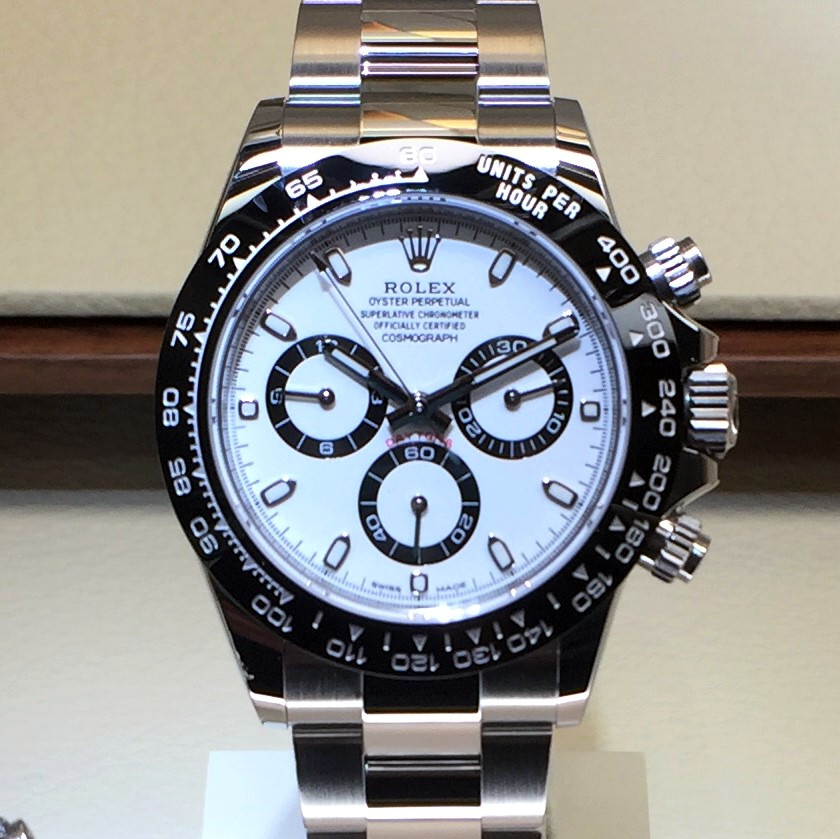
Rolex Cosmograph Daytona 116500LN-0001
TAG Heuer Monaco
The Heuer Monaco didn’t appear until 1969, marking its 50th anniversary in 2019 (helping prompt this article). Jack Heuer named this timepiece after the iconic Monaco Grand Prix, and with its different shaped cased it stood out from other watches just as the Monaco Grand Prix stands out in the racing calendar each year. It marked a complete break in the aesthetic traditions of watchmaking, with a square case and the crown on the left-hand side at 9 o’clock, opposite the chronograph pushers at 3 o’clock.
The Monaco’s race debut was adorning the wrist of Jo Siffert in 1970, but it was propelled to fame and iconic status when the legendary Steve McQueen wore it during the 1971 film Le Mans. The Monaco has been a favourite collection from Heuer, and latterly TAG Heuer, and whilst it can still be purchased in its original aesthetics with the same calibre 11 movement, it is also accompanied by more contemporary models and has even been the subject collection for TAG Heuer concept watches.
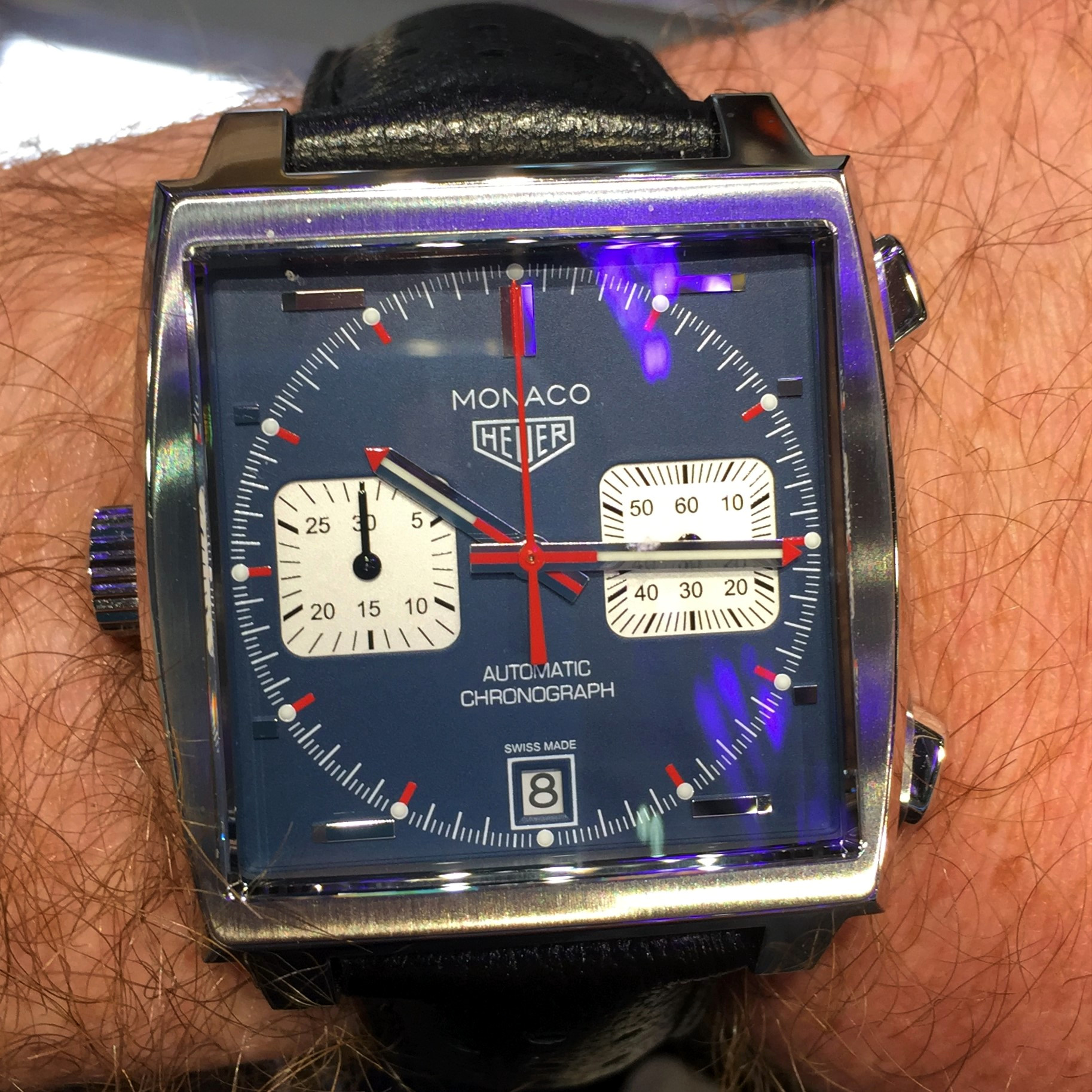
TAG Heuer Monaco CAW211P.FC6356
Motor racing is inherent in the DNA of TAG Heuer, from 1911 and the ‘Trip of Time’ and in addition to the Monaco collection, there is also the Carrera collection (named after the Carrera Panamericana road-race in Mexico between 1950-1954) and their popular Formula 1 collection. TAG Heuer remain an affiliate of the Red Bull Formula 1 team and have even released a Formula 1 model in association with Aston Martin.
These two iconic examples illustrate the foundations of the relationship between watches and cars and where this relationship has been so successful. That being said, there are a multitude of other luxury watch brands with an affiliation with motor racing too:
Chopard, Mille Miglia
The famous Mille Miglia road-race first ran in Brescia in 1927 and was started to compensate the loss of the Italian Grand Prix. It was discontinued for safety reasons in 1957, before being re-instantiated as an exclusive, classic car endurance race where only models of car which competed during the original 1927-1957 window can take part. Chopard has been sponsor and timekeeper of the Mille Miglia since 1988, and their Mille Miglia collection celebrates the spirit and the aesthetics belonging to the vintage cars which raced in the original road-races.
Bremont, Jaguar
Bremont as a brand reflects traditional engineering values and is proud to base their operations out of Henley-upon-Thames in England. It comes as no surprise that the chosen automotive association for Bremont then is Jaguar, famously English and founded in 1922. The Jaguar collection was inspired by the classic Jaguar E-Type, and affectionately incorporates design cues embodying the spirit of the E-Type, even down to the steering wheel rotor and original type marking pattern around the crown. The 2019 D-Type limited edition release was even designed directly in conjunction with Jaguar design director Ian Callum.
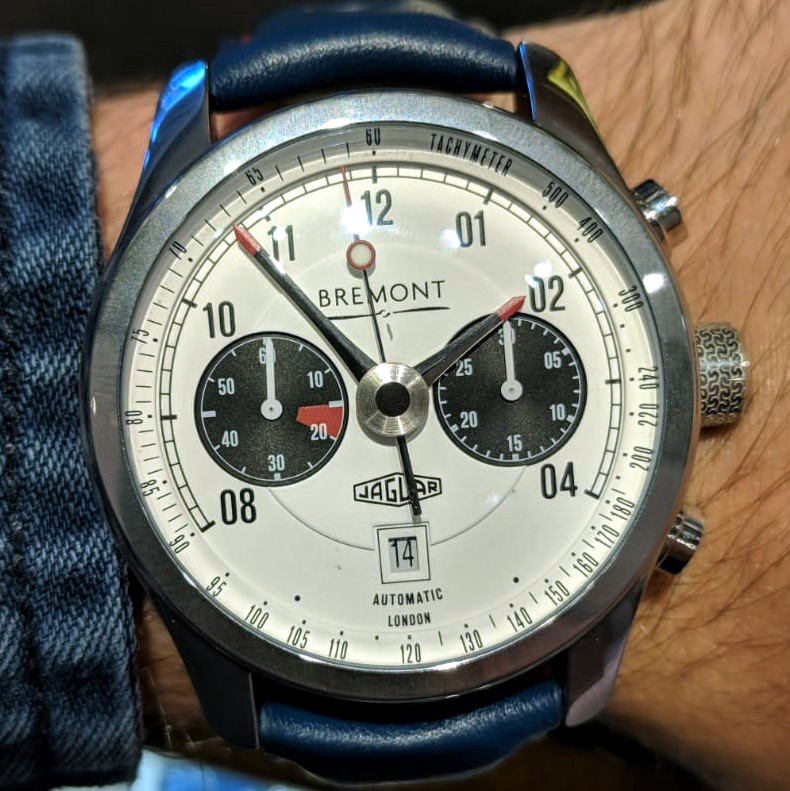
Bremont Jaguar: BJ-II-WH-R
Omega, Speedmaster
Whilst Omega maintains several affiliations with the sporting world, most notably the Olympic games, they aren’t currently directly affiliated with motor sport. That doesn’t mean however that they do not have associate timepieces – perhaps one of the most iconic chronographs around is the Omega Speedmaster. It is of course known for being the first watch on the moon, but the Speedmaster collection does include a Racing family, with models specifically incorporating design cues to celebrate the time the Speedmaster spent adorning the wrists of racing drivers during the golden era of racing before its giant leap into space.
Blancpain, Blancpain GT Series
The current Blancpain collections might not necessarily directly embody the spirit of motor racing, yet there are discontinued, sportier collections which do connote the relationship between cars and watches. The best examples of this are the L’Evolution and Leman collections, both regularly incorporating various incarnations of chronograph as well as materials such as carbon fibre and aesthetic cues to match. Additionally, Blancpain partnered with the SRO Motor Group to create the Blancpain Endurance Series in 2011, and more recently the Blancpain GT Series.
Breitling, Bentley
Breitling’s partnership with Bentley is one they are rightly proud of, having first been established in 2003 when Breitling were tasked with designing and on-board clock for the Bentley Continental GT. Breitling were carefully chosen for this task based on their rich history working with on-board clocks used in aviation and automotive dashboards. It is also a romantic footnote that Willy Breitling, grandson for founder Léon Breitling, was a huge fan of Bentleys and has a collection of many. This relationship between the two luxury manufacturers cultivated the since discontinued Breitling for Bentley collection, although there remain special Bentley editions of the recent Premier collection launch.
IWC Schaffhausen, AMG
Since 2013, IWC Schaffhausen has been the official Engineering Partner of the Mercedes AMG Formula 1 team, celebrating the parallels of precision and high-performance engineering in luxury watchmaking and elite motor sport. Additionally, since 2015 IWC have been the official Timing Partner of the Goodwood Members Meetings which were re-instantiated in 2014. These events used to take place between 1949 and 1966 when the Goodwood racetrack was used for Formula 1 events, reserved exclusively for members.
Whilst these partnerships have tended to focus very much on the traditions and origins of the relationship, there are also both watch and car brands which like to push the boundaries of convention – take for example a modern supercar and a 1960s Aston Martin DB5: inherently different aesthetics and performance, yet ultimately the product of the same desires from different eras. It seems only appropriate to reflect this within horology, too, and there are watch brands doing just this:
Hublot, Ferrari
The partnership between Hublot and Ferrari begun in 2011 and is very much focused on celebrating the fusion between these two brands in creating innovative, high-performing timepieces. This has seen the creation of the Hublot MP-05 “LaFerrari” which was created in tandem with the car and introduced an incredible 50-day power reserve – a new world record. More recently the partnership has produced the Techframe Ferrari Tourbillon Chronograph, which was in fact designed by Ferrari themselves, to celebrate Ferrari’s 70th anniversary.
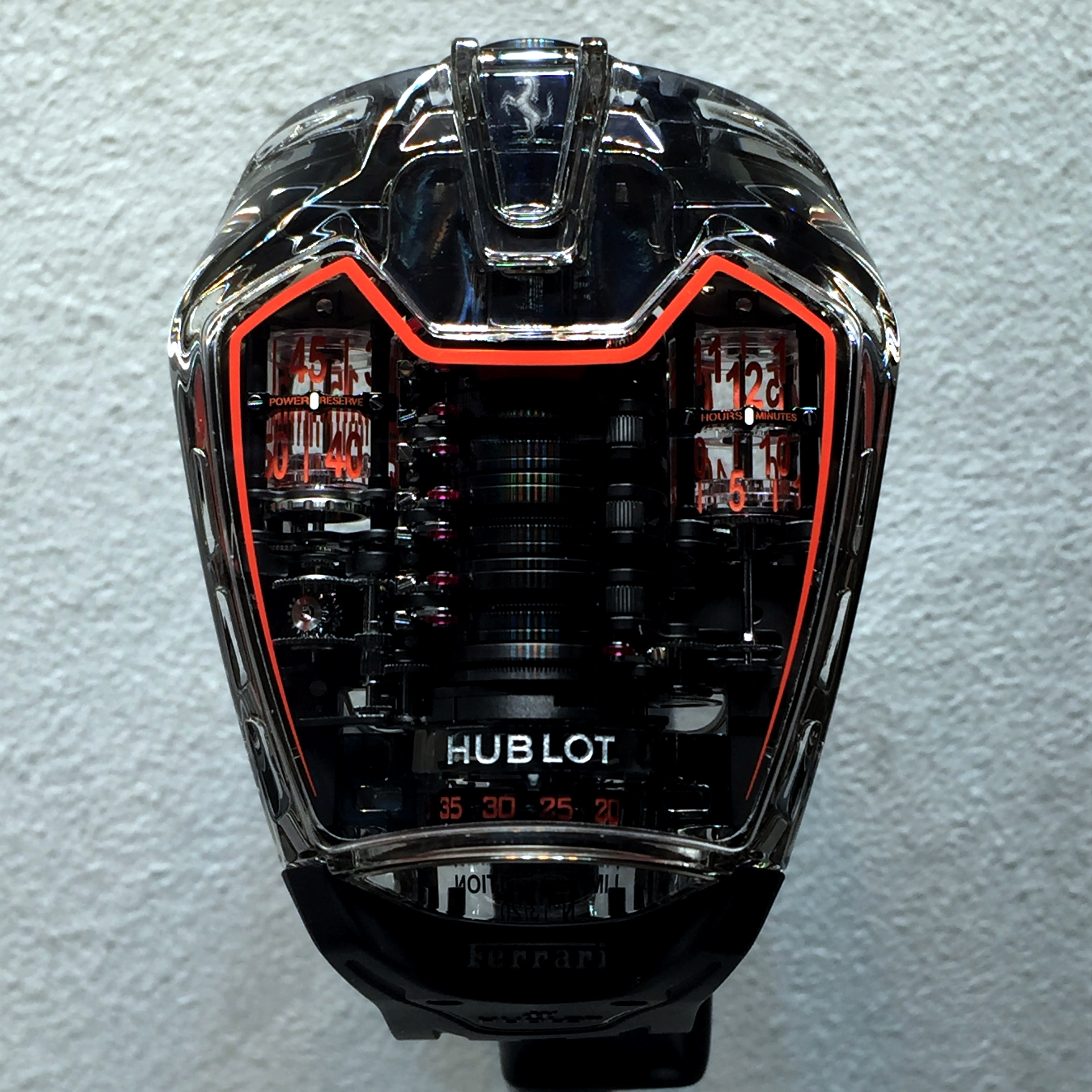
Hublot MP-05
Roger Dubuis, Lamborghini
Roger Dubuis as a brand have always sought to be different and to stand out. So, when they announced a new five-year partnership in 2017, their chosen partner could not have been any more perfect an association in Lamborghini, with both brands have a distinctive and strong philosophy of their design. The partnership has produced a series of limited-edition timepieces specific to the Lamborghini partnership, with a hallmark of incorporating a tilted balance wheel. Additionally, unlike many other collaborations born of the relationship between cars and watches, Roger Dubuis has happily and willfully ignored the previous conventions of including a chronograph, focusing instead on innovative design and material use.
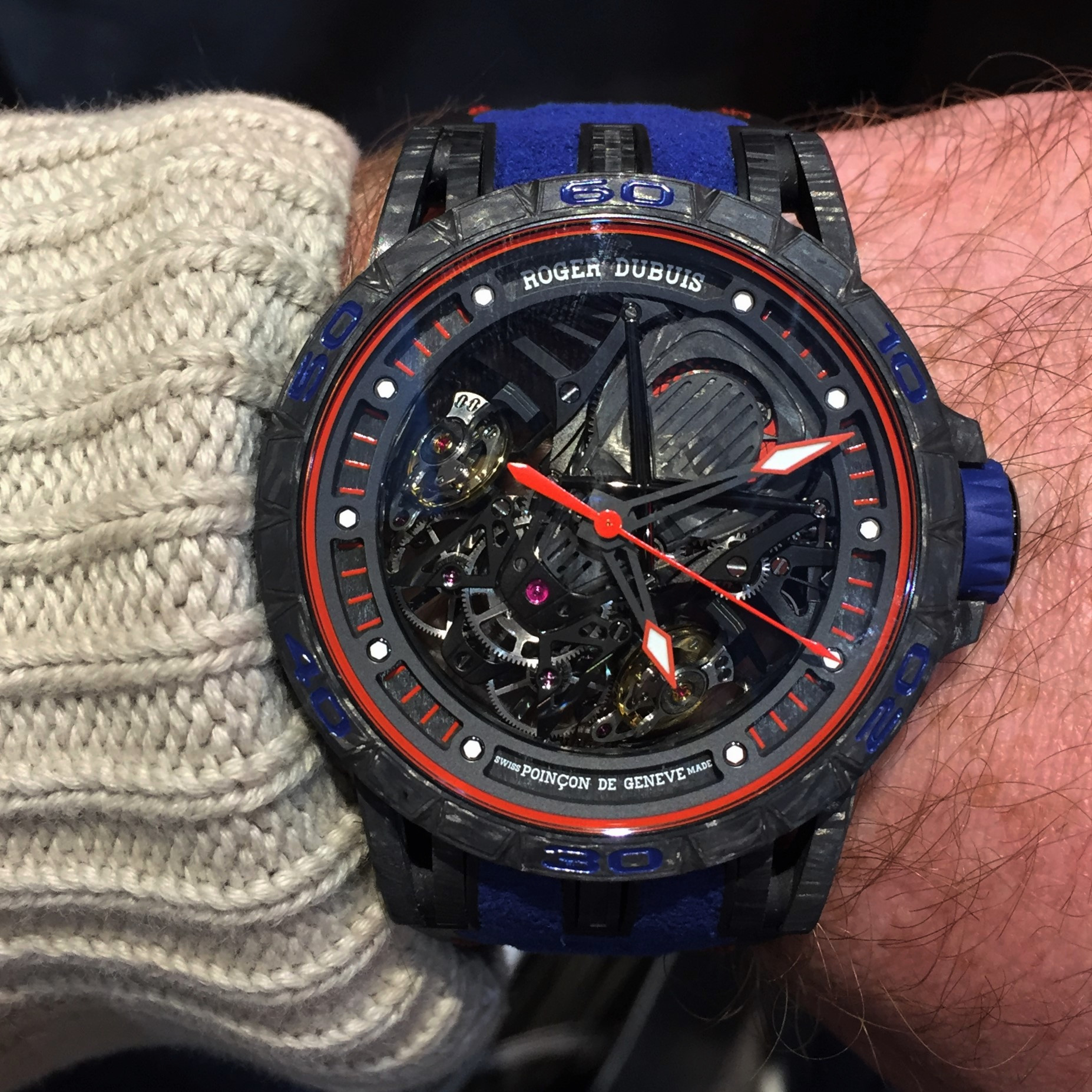
Roger Dubuis Excalibur RDDBEX0686
There are more relationships between watches and cars too
There are of course many other examples of collaborations between watches and cars, from brands such as Richard Mille, Baume et Mercier, Laurent Ferrier, and Bell & Ross to name but a few. Ultimately though, whilst the origins of the relationship can be traced very much to the chronograph and concurrent rise of motor sport during the 1950s and 1960s, it is the need for, and appreciation of, precision engineering, innovative design and material use, that has driven the engines of both watches and cars to new superlative levels of performance.
This might be well-surmised by considering the London Concours car show, of which Breguet is main sponsor. Whilst Breguet themselves do not have a direct affiliation or with motor sport, or any partnerships with automobile manufacturers, I can say from experience that there is certainly something that can be said about an environment where one can enjoy both the technical brilliance and history of Breguet, whilst in the company of some of the most exceptional and iconic cars from history.
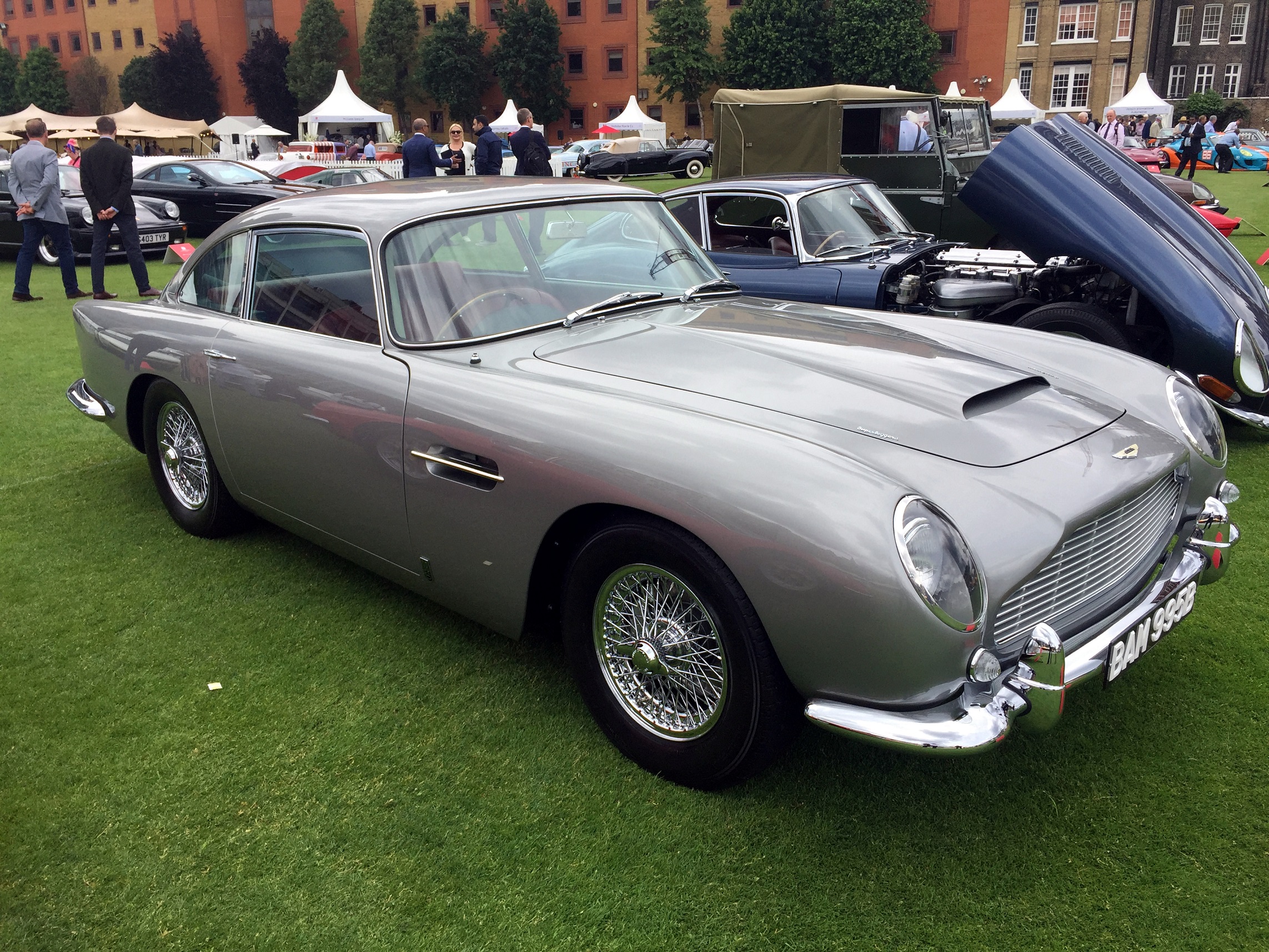
Aston Martin DB5 at the London Concours
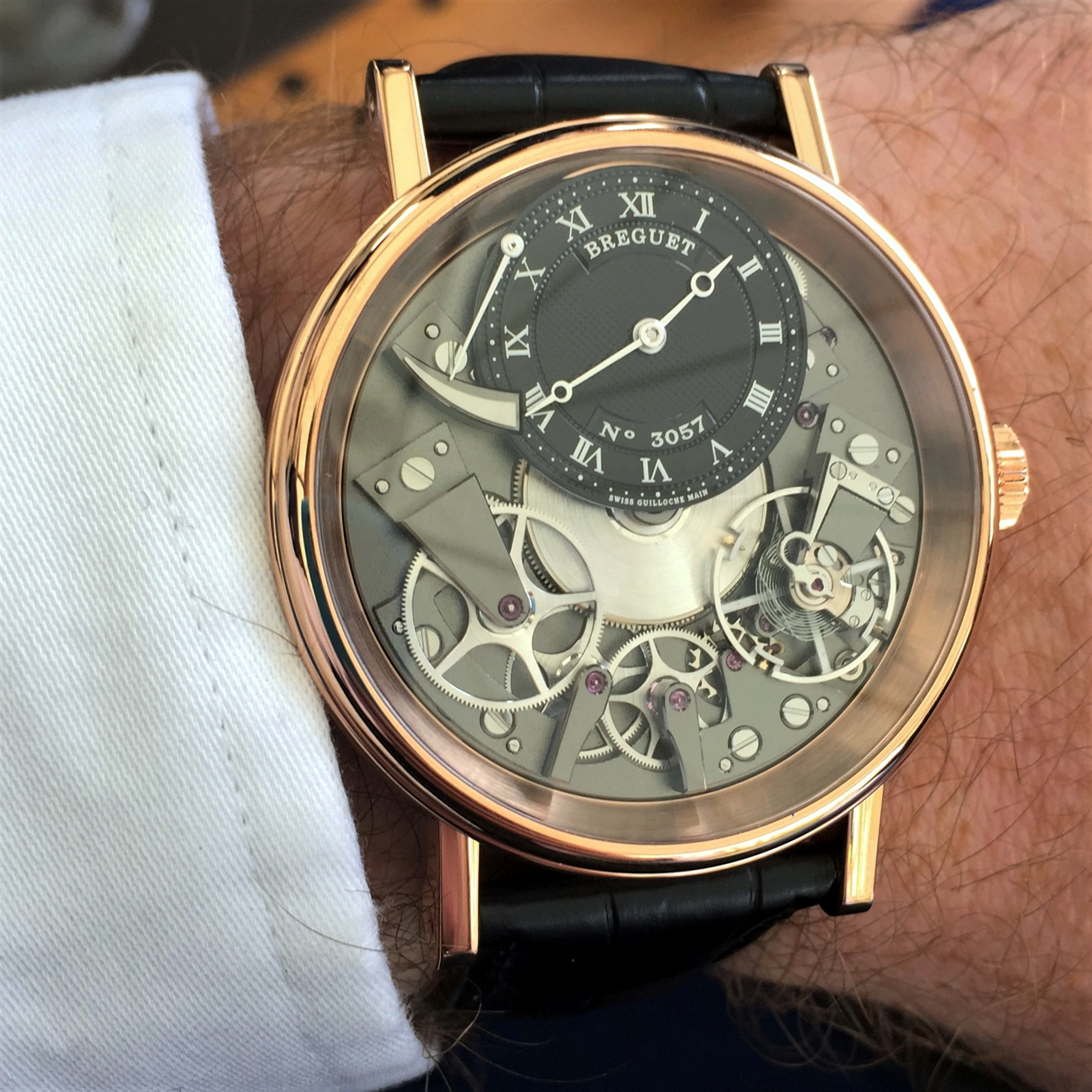
Breguet Tradition: 7057BR/G9/9W6
Watches and cars, cars and watches – a match made in history, and enthusiasts of one will almost certainly enjoy the other, too.
If you have any questions, please get in touch via our Contact page, or via our Instagram.
You might also be interested in:
- Spotlight: TAG Heuer Carrera
- Spotlight: Laurent Ferrier
- “It’s complicated”: an introduction to the Chronograph
- Watch Stationery and Gift Ideas
- Watch Books, Watch Boxes and more at the Watch Affinity Shop on Amazon (commissions earned)
As an Amazon Associate, I earn from qualifying purchases – thank you for your support

